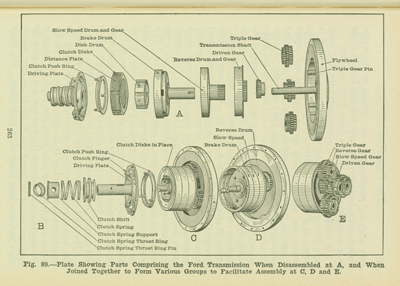|
One of the most dramatic displays in Henry Ford Museum is the “exploded” Model T—a 1924 Model T touring car with its constituent parts suspended by wires. Located at the entrance to the Made in America exhibition, it invites visitors to take a different look at an iconic American product.
Henry Ford’s Model T automobile is one of the most significant technological devices of the 20th century. Its clever engineering and low price allowed it to do what could only be done once—make the automobile widely popular. The Model T spawned mass automobility, altering our living patterns, our leisure activities, our landscape, even our atmosphere. The Model T’s influence is so pervasive and lasting that even people who know little about old cars or automotive history know the name “Model T.”
But the way the Model T was produced is as iconic as the car itself. When Ford Motor Company introduced the Model T in October 1908, firearms, watches, and sewing machines were already being assembled from interchangeable parts made on specialized machines. Ford successfully adapted these techniques to the much more complex automobile, and then crowned this achievement with the development of the moving assembly line in late 1913. To see a video of the Model T assembly line at work, click here.
The assembly line became the 20th century’s characteristic production mode, eventually applied to everything from refrigerators to hamburgers. An ever-widening stream of affordable goods flowed from American factories. High wage, low skilled assembly line jobs accelerated both immigration from overseas and the movement of Americans from the farms to the cities. The same jobs also accelerated the movement of the same people into an ever expanding middle class. The American standard of living was literally built on assembly lines.
But most people are far more familiar with the products of the assembly line than the process itself. When curators planned the Made in America exhibition in the early 1990s they struggled with how best to illustrate the complex problem of assembling the Model T. They fell back on an idea developed in Italy in the late 1400s. Renaissance engineers Leonardo da Vinci and Francesco di Giorgio were perhaps the first to draw the parts of complex mechanical devices spread out in the order in which the parts were assembled. Click here to see Leonardo’s exploded drawing of a ratchet device, done around the year 1500.
These “exploded” drawings became a common technique used in operating and repair manuals. Ford used them in Model T manuals. The exploded Model T is a three-dimensional version of an exploded drawing. When visitors encounter it, and the nearby large and small artifacts from the Model T assembly plant, they are transported to the time and place that profoundly shaped the world in which they still live.
 |
Exploded drawing of a Model T planetary transmission from a 1920s Model T service manual. THF.34110 |
Da Vinci and di Giorgio would no doubt love the exploded Model T, but so would Henry Ford. While Henry could read and use drawings, he always preferred to use physical models whenever possible. Joseph Galamb, one of the engineers who helped design the Model T, said that Ford “liked to see a model working first. He didn’t like to go just by the blueprint.” Henry Ford, who saw his museum and village as tools for educating people about past technologies and their links to the present, would have approved of the way we “blew up” his Model T.
| |
-- Bob Casey, Senior Curator of Transportation |
|

